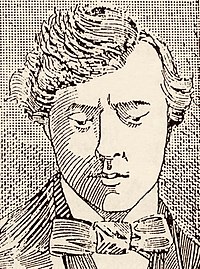Francis Webb Sheilds
Francis Webb Sheilds | |
|---|---|
 | |
| Born | (1820-10-08)8 October 1820 Ireland |
| Died | 18 January 1906(1906-01-18) (aged 85)[1] Southampton |
| Other names | Francis Webb Wentworth-Sheilds[2] |
| Occupation | Rail Engineer |
| Known for | Sydney Railway Company |
| Spouse | Adelaide Baker (m.1860) |
| Children | Wentworth Wentworth-Sheilds Francis Wentworth-Sheilds |
| Parent(s) | Rev. Wentworth Sheilds Isabella Plunkett |
| Relatives | John Gore Sheilds (brother) |
Francis Webb Wentworth-Sheilds (born Sheilds; 8 October 1820 – 18 January 1906)[3] was an Anglo-Irish civil engineer on the Sydney Railway Company during its construction but before its opening.
In Great Britain and Ireland, Sheilds worked on a number of railway projects, including the then 4 ft 8+1⁄2 in (1,435 mm) Dublin and Kingstown Railway. He considered himself to be a born railway engineer.[4]
City Surveyor
Sheilds was the Sydney City Surveyor in 1843 for a few years where he worked on water works. He resigned in 1849,[5] in order to take up a post with the Sydney Railway Company.
Sydney Railway Company engineer
Sheilds is mainly remembered because he persuaded the company to adopt the 5 ft 3 in (1,600 mm) rail gauge, rather than the English standard gauge of 4 ft 8+1⁄2 in (1,435 mm). Sheilds had worked on railways in Ireland, which had adopted 5 ft 3 in (1,600 mm) as its own standard gauge. His proposal was backed by the British Board of Trade, and agreed to by all Australian colonies.
Sheilds resigned in 1850[6] when his pay was cut due to the company's financial difficulties. His replacement, Scotsman James Wallace, recommended that the track gauge be changed to the 4 ft 8+1⁄2 in (1,435 mm), and the New South Wales government concurred. However, the construction of 5 ft 3 in (1,600 mm) broad gauge lines had already started in Victoria and South Australia, and the necessary rolling stock had been ordered. The two colonies strongly protested about the change and declined to follow suit.
Sheilds's recommendation, and its overturning by New South Wales, is the origin of the huge problems caused by breaks of gauge between 5 ft 3 in (1,600 mm) and 4 ft 8+1⁄2 in (1,435 mm) rail tracks in Australia. To add to the predicament, most other Australian colonies, including parts of South Australia, later adopted the cheaper narrow gauge of 3 ft 6 in (1,067 mm). Tasmania's first railway was constructed with a 5 ft 3 in (1,600 mm) gauge, as per the original agreement, but it was converted to 3 ft 6 in (1,067 mm) in 1888.
See also
References
- ^ Obituary. Francis Webb Wentworth-Sheilds, 1820-1906.
- ^ Burke's Peerage assumed by Royal licence the prefix surname Wentworth 1877
- ^ "Death of the Archdeacons Father". Wagga Wagga Express. NSW: National Library of Australia. 6 March 1906. p. 2. Retrieved 20 June 2014.
- ^ "ABSTRACT OF THE EVIDENCE TAKEN BEFORE THE SELECT COMMITTEE ON RAILWAYS, &c". The Sydney Morning Herald. National Library of Australia. 13 July 1848. p. 2. Retrieved 27 August 2011.
- ^ "SYDNEY". The Courier. Hobart, Tas.: National Library of Australia. 10 March 1849. p. 2. Retrieved 3 July 2014.
- ^ "Advertising". The Sydney Morning Herald. National Library of Australia. 13 December 1850. p. 1. Retrieved 3 July 2014.
- Wentworth-Sheilds Family History details
- Hagarty, Donald; Australian Railway Historical Society. New South Wales Division (2005), The building of the Sydney Railway : the known story of the work of six men – a naval surveyor, four engineers, and the contractor who, with many others, built the first railway from Sydney to Parramatta 1848–1857, Australian Railway Historical Society, New South Wales Division, ISBN 978-0-9757870-1-4
External links
- Works by or about Francis Webb Sheilds at Internet Archive
- v
- t
- e
  | This article about an Australian engineer, inventor or industrial designer is a stub. You can help Wikipedia by expanding it. |
- v
- t
- e











